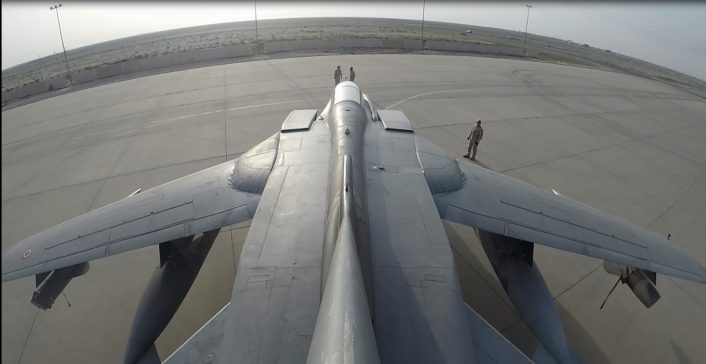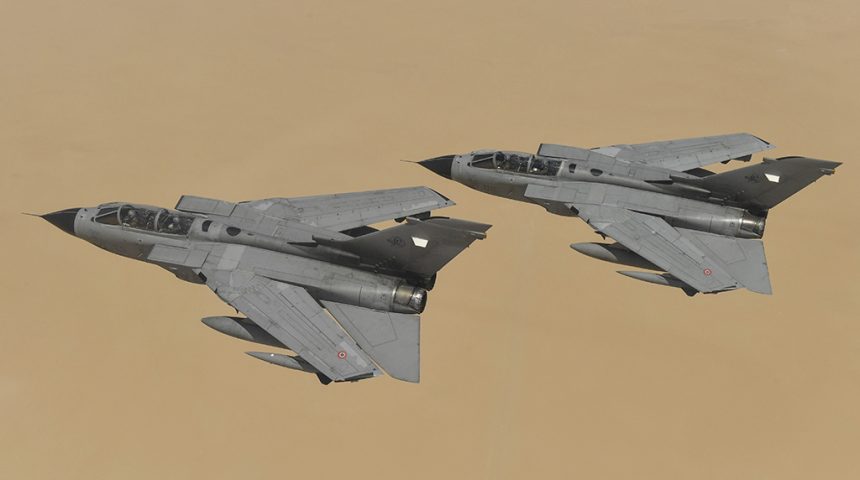The Tornado IDS jets of the Italian Air Force Task Group “Devil” have surpassed 4,000 flight hours in support of Operation Inherent Resolve.
The Italian Tornado IDS aircraft, belonging to the 154° Gruppo (Squadron) of the 6° Stormo (Wing) of the Italian Air Force, from Ghedi Air Base, Italy, deployed to Ahmed Al Jaber airbase, Kuwait, have recently celebrated the achievement of 4,000FH (flight hours) flying reconnaissance missions in support of OIR (Operation Inherent Resolve), the multi-national coalition fighting Daesh in Iraq and Syria.
“The thousands of hours flown in operational missions, the targets and points of interest covered by the Task Group “Devil” in support of Operation Inherent Resolve are the result of the ability to work as a team, to keep the structure ready and fully efficient, to identify and promptly resolve problems and criticalities; these are all key qualities that allow the Tornado to be operationally effective, today, and for several years to come” said Col. Luca Giuseppe Vitaliti, Commander of the Italian National Contingent Command Air and Task Force Air Kuwait, addressing the Task Group on Feb. 14, 2021.
The four Italian “Tonkas”, officially designated A-200A/C, operate as part of Task Group Devil, under the Italian Nation Contingent Command Air/Task Force Air Kuwait supporting “Prima Parthica” (as the Italian Armed Forces operation is dubbed at national level), established on Oct. 17, 2014.

The Tornado IDS aircraft have arrived in Kuwait on Aug. 12, 2020, to replace the Italian Air Force Eurofighter Typhoons of the Task Group Typhoon, which had been deployed since Mar. 26, 2019, when they replaced the Task Group Black Cats (equipped with AMX A-11 Ghibli). Since then, in about 6 months, the aircraft have collected imagery of 5,000 targets during 4,000FH: for comparison, during their first tour in support of OIR, from the end of 2014 to March 2016, the Tornados of the 6th Wing logged “only” 3,000FH on about 2,000 targets.
While the optempo has increased, the mission of the Tornados over Iraq has remained the same flown in Afghanistan, from November 2008 to December 2009, when the Italian A-200s were deployed to Mazar-i-Sharif, Afghanistan, and in Libya, in 2011, during Operation Unified Protector: they carry out “recce” missions with the RecceLite pod.
As explained in detail in a previous post, the Rafael Reccelite II reconnaissance pod is the Italian Air Force’s tactical pod of choice to carry out ISR missions. It is a Day/Night electro-optical pod able to provide real-time imagery collection by means of a stabilized turret, solid-state on board recorder that provides image collections in all directions, from high, medium and low altitudes, and datalink to transmit live video imagery to ground stations and to ROVER (Remote Operations Video Enhanced Receiver) tactical receivers in a range of about 100 miles.
Along with the RecceLite pod, the standard loadout of the Italian Tornado in Kuwait includes two drop tanks and two ECM pods, one of those is an upgraded BOZ-102 EC (Enhanced Capability) podded self-protection system.









